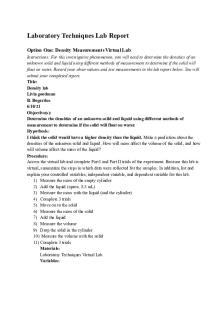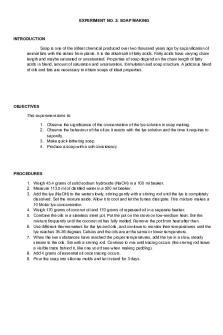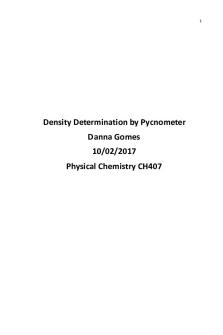PHY1 ME Laboratory Report 8 Waves And Acoustics PDF

| Title | PHY1 ME Laboratory Report 8 Waves And Acoustics |
|---|---|
| Course | Physics For Engineers |
| Institution | Pangasinan State University |
| Pages | 11 |
| File Size | 447.5 KB |
| File Type | |
| Total Downloads | 72 |
| Total Views | 135 |
Summary
This is an study about waves and acoustics on the subject course Physics For Engineers....
Description
NAME: J SUBJECT/SECTION: PHYSICS FOR ENGINEERS BSME-1A DATE: MAY 30, 2021
SCORE
EXPERIMENT #8 WAVES AND ACOUSTICS Abstract This experiment or laboratory report is all about waves and acoustics. A wave is a disturbance or oscillation that travels through space-time and is accompanied by an energy transfer. For transverse waves, the propagation direction is perpendicular to the oscillation direction. A wave transfers energy rather than moving mass in the direction of propagation. The purpose of this experiment is to determine what factors affect the frequency and the period of a vibrating mass on a spring and to state the relationship between those variables and the frequency or period. As the experiment goes on, the researcher solve the problem in this activity and was tabulated and presented in every activity forms. The researcher also answered some following questions on this experiment and support his answer in every question. Using the provided link for this activity, the researcher manage to finish it. Answered some following activity forms and compute some given problems. It was compiled and presented in Appendices section. It was expected that the researcher had learn and got the idea on how waves and acoustics connected to each other. The researcher concluded that, as the frequency increases, the period of time and frequency decreases. Using some simulations, it helps the researcher to understand more about waves and sounds and gain new knowledge about it through answering and solving some small problems. I.
Introduction A wave is a disturbance or oscillation that travels through space-time and is accompanied by an energy transfer. For
transverse waves, the propagation direction is perpendicular to the oscillation direction. A wave transfers energy rather than moving mass in the direction of propagation. Wave motion transports energy from one point to another without causing permanent movement of the medium’s particles. Depending on the direction of oscillation, a wave might be transverse or 1|Page
longitudinal. When a disturbance creates oscillations perpendicular (at right angles) to the propagation, transverse waves arise (the direction of energy transfer). When the oscillations are parallel to the propagation direction, longitudinal waves arise. Electromagnetic waves are all transverse, but mechanical waves can be both transverse and longitudinal. A longitudinal wave is, for example, sound. For each unique occurrence of a wave process, the description of waves is strongly tied to their physical genesis. Acoustics, for example, differs from optics in that sound waves are created by mechanical vibration rather than electromagnetic (light) wave propagation. As a result, concepts like mass, momentum, inertia, and elasticity play an important role in understanding acoustic (as opposed to visual) wave dynamics. Because of the variation in origin, various wave characteristics specific to the qualities of the medium are introduced. The purpose of this experiment is to determine what factors affect the frequency and the period of a vibrating mass on a spring and to state the relationship between those variables and the frequency or period. II. Materials and Methods Materials/Equipments 1. Mass on a Spring Interactive 2. Simple Wave Simulator Instruction Part 1 1. Visit the link provided: https://www.physicsclassroom.com/Physics-Interactives/Waves-and-Sound/Mass-on-aSpring/Mass-on-a-Spring-Interactive 2. Visit the link for the activity: https://www.physicsclassroom.com/Physics-Interactives/Waves-and-Sound/Mass-ona-Spring/Mass-on-a-Spring-Exercise Part 2 1. Visit the link provided: https://www.physicsclassroom.com/Physics-Interactives/Waves-and-Sound/Simple-WaveSimulator/Simple-Wave-Simulator-Interactive 2. Visit the link for the activity: https://www.physicsclassroom.com/Physics-Interactives/Waves-and-Sound/SimpleWave-Simulator/Simple-Wave-Simulator-Exercise-1 2|Page
III. Results As the experiment goes on, the researcher solve the problem in this activity and was tabulated and presented in every activity forms. The researcher also answered some following questions on this experiment and support his answer in every question. IV. Discussion Using the provided link for this activity, the researcher manage to finish it. Answered some following activity forms and compute some given problems. It was compiled and presented in Appendices section. It was expected that the researcher had learn and got the idea on how waves and acoustics connected to each other. V. Conclusion The researcher concluded that, as the frequency increases, the period of time and frequency decreases. Using some simulations, it helps the researcher to understand more about waves and sounds and gain new knowledge about it through answering and solving some small problems. VI. References https://courses.lumenlearning.com/boundlessphysics/chapter/waves/#:~:text=A%20wave%20can%20be%20thought,of%20propagation%3B%20it%20transfers%20e nergy. https://www.physicsclassroom.com/Physics-Interactives/Waves-and-Sound/Mass-on-a-Spring/Mass-on-a-SpringInteractive https://www.physicsclassroom.com/Physics-Interactives/Waves-and-Sound/Mass-on-a-Spring/Mass-on-a-SpringExercise https://www.physicsclassroom.com/Physics-Interactives/Waves-and-Sound/Simple-Wave-Simulator/Simple-WaveSimulator-Interactive https://www.physicsclassroom.com/Physics-Interactives/Waves-and-Sound/Simple-Wave-Simulator/Simple-WaveSimulator-Exercise-1 http://www.physicsclassroom.com/Physics-Interactives/Waves-and-Sound/Mass-on-a-Spring www.physicsclassroom.com 3|Page
http://www.physicsclassroom.com/Physics-Interactives/Waves-and-Sound/Simple-Wave-Simulator Appendices Mass on a Spring Interactive Purpose: To determine what factors affect the frequency and the period of a vibrating mass on a spring and to state the relationship between those variables and the frequency or period. Getting Ready: Navigate to the Vibrating Mass on a Spring Interactive at The Physics Classroom website: http://www.physicsclassroom.com/Physics-Interactives/Waves-and-Sound/Mass-on-a-Spring Navigational Path: www.physicsclassroom.com ➔ Physics Interactives ➔ Waves and Sound ➔ Vibrating Mass on a Spring Getting Acquainted: Once you’ve launched the Interactive and resized it, experiment with the interface. Place a mass on the end of the spring and observe the vibration. Click/tap the Start button to view the plot of its vertical position as a function of time. Reset the system and place a mass on each spring and observe that their graphs are color coded --‐ consistent with the color of the spring. Notice that the time, height, and velocity of the mass are reported below the graphs. And most importantly for this lab, observe how the vertical line on the graph can be moved along the axis in order to obtain values of height and velocity at various times on the graph. The Challenge: Your challenge is to determine what factors affect the frequency and the period of a vibrating mass on a spring. Make your study of this question very systematic --‐ varying one factor at a time while you hold others constant. You can easily test the mass and the stiffness of the spring as possible factors. If you are “quick,” you might also be able to test damping as a possible factor.
4|Page
Conduct several trials for each variable under study. For each trial, measure the period by recording the difference in time from the start and the end of one cycle or of several cycles. Use the provided tables. Not all columns or rows will necessarily be use d. Factor #1: Change in Mass Factor:
# of Cycles
Mass
Start Time (s)
Stop Time (s)
Period (s)
Frequency (Hz)
1kg
6
0.33s
3.39s
0.51s
1.96Hz
2kg
2
0.59s
2.07s
0.74s
0.68Hz
3kg
3
0.58s
3.25s
0 89s
1.12Hz
4kg
4
0.63s
4.73s
1.025s
0.98Hz
Factor #2: Change in Stiffness Factor:
# of Cycles
Mass
Start Time (s)
Stop Time (s)
Period (s)
Frequency (Hz)
1kg
4
0.22s
1.82s
0.4s
2.5Hz
2kg
5
0.45s
3.27s
0.564s
1.77Hz
3kg
3
0.72s
2.79s
0.69s
1.45Hz
4kg
2
0.37s
1.97s
0.8s
1.25Hz
Factor #3: Change in Damping
Factor:
# of Cycles
Mass
Start Time (s)
Stop Time (s)
Period (s)
Frequency (Hz)
1kg
2
0.34s
1.19s
0.425s
2.35Hz
2kg
4
0.37s
2.1s
0.4325s
2.31Hz
3kg
3
0.41s
2.49s
0.69s
1.45Hz
4kg
2
0.48s
2.07s
0.795s
1.26Hz
5|Page
Conclusion: Identify the factors that affect the frequency and the period of a vibrating mass on a spring. For each factor having an effect, describe the effect (e.g., state something like … “As the -
increases, the period and the frequency
.”)
As the frequency increases, the period of time and the frequency decreases. Exploring Waves
Purpose: To explore a few simple characteristics of waves traveling along a rope and sound waves traveling through air. Getting Ready: Navigate
to
the
Simple
Wave
Simulator
Interactive
at
The
Physics
Classroom
website:
http://www.physicsclassroom.com/Physics-Interactives/Waves-and-Sound/Simple-Wave-Simulator Navigational Path: www.physicsclassroom.com ➔ Physics Interactives ➔ Waves and Sound ➔ Simple Wave Simulator Getting Acquainted: Once you’ve launched the Interactive and resized it, experiment with the interface. Tap on the Slow Motion, Real Time, and Fast Motion tabs at the top of the interface to observe how to control the tempo of the animation. Toggle back and forth between a sound wave and a rope wave by tapping on the Show Wave as … button. Finally, observe the sliders at the bottom of the interface for controlling the Frequency, Wave Speed, and Wave Amplitude.
6|Page
Exploring Waves on a Rope Set the animation to Show Waves on a Rope using a Real Time tempo and Frequency, Wave Speed, and Wave Amplitude values of 0.10 Hz (approximately), 100 cm/s, and 2 cm respectively. Then use the controls on the animation to answer the following questions. 1. In Physics, we distinguish between wave motion and particle motion. Wave motion refers to the movement of a wave-like pattern from one location on the medium to another. When you view a water wave moving along the surface of water, you are observing wave motion. There is a very obvious movement of a collection of crests and troughs along the water surface. In the Simple Wave Simulator, there is a collection of crests and troughs moving through a rope; this is wave motion. But there are also three points on the rope that are colored red. When you observe the motion of these points, you are observing particle motion – the motion of particles of the rope. Describe the motion of these particles. -
The particles moves in accordance with the rope’s movement.
2. If you observe closely, you will notice that the particles leave a trail behind them as they move. The longer the trail, the faster that the particle is moving. During any up-and-down cycle of the particle, does it move with a constant speed or with a changing speed? If the speed is changing, at what point during its motion does it move with the greatest speed? The smallest speed? Discuss fully. 3. There are a variety of ways to categorize waves. One way is to categorize waves as being transverse waves, longitudinal waves, or surface waves. Waves in each of these categories differ from one another in terms of how the direction of the particle motion compares to the direction of the wave motion. The waves traveling through the rope are transverse waves. For transverse waves, compare the direction that the particles move to the direction that the wave moves? 4. Now use the Frequency slider to increase the frequency to a high value. Compare the motion of the particles when the frequency is high to the low-frequency motion. How would you describe the difference? 5. This next step is going to take some skill and some careful observation. The wave speed is associated with the movement of crests and troughs along the medium. Faster waves will have crests that move from the left side of the screen to the right side of the screen in less time; that is the crests move from left to right faster. Set the animation to a low frequency (about 0.1 Hz) and observe the wave speed. It might help to put your finger or a pen cap on a crest and follow move your finger (or pen cap) from left to right along with the crest. Then repeat for a high frequency (about 1.0 Hz). Make the same 7|Page
observation of wave speed – the speed of the crest moving from let to right across the screen. Does this ten-fold increase in frequency – from about 0.1 Hz to about 1.0 Hz – have any noticeable and appreciable effect upon the wave speed? Explain your answer and discuss your observations. 6. Does moving the Frequency slider from a low to a high value change the listed Wave Speed in this animation? Circle: Yes
No
7. Change the Wave Amplitude from a high value to a low value. In terms of particle motion, how would you describe the difference between a high amplitude wave and a low amplitude wave? 8. Does a change in amplitude effect the wave speed? Run two tests with high and low amplitude using a similar procedure used in Question #5. Make a claim and support your answer with evidence. 9. The wavelength of a wave refers to the length of the repeating pattern of crests and troughs. Long wavelength waves have crests that are spaced relatively far apart. Short wavelength waves have crests that are relatively close to each other. Use the controls to determine two ways to increase the wavelength of the waves. Describe what you did to increase the wavelength. Exploring Sound Waves Set the animation to Show Waves as Sound using a Real Time tempo and Frequency, Wave Speed, and Wave Amplitude values of 0.10 Hz (approximately), 100 cm/s, and 2 cm respectively. Then use the controls on the animation to answer the following questions. 10. Observe the motion of the three colored air particles. Describe the motion of these particles for a sound wave moving through air. -
They come towards each other when the wave is at its tallest, and they drift apart when it’s at its lowest.
11. Use the Frequency slider to observe the effect of frequency upon the motion of particles in the medium. How does the particle motion differ for a high frequency wave compared to a low frequency wave? 12. Sound waves traveling through air are a type of wave known as a longitudinal wave. For longitudinal waves, compare the direction that the particles move to the direction that the wave moves? 8|Page
Assessment Use your explorations of waves on a rope and waves through the air to answer these questions. 1.
As a transverse wave travels through a rope from left to right, the parts of the rope .
a.
move along a line from left to right
b.
oscillate back and forth about a fixed location
c.
move along a sine-wave like path from left to right
2.
For a transverse wave, the particles of the medium move to the direction that the wave moves.
a.
perpendicular b. parallel
3.
For a longitudinal wave, the particles of the medium move
a.
perpendicular
4.
The frequency of a wave describes
a.
how fast a point on the wave moves along the medium
b.
how often particles of the medium oscillate back and forth
c.
how far particles move away from their normal resting position
5.
Increasing the frequency with which particles within a rope vibrate will cause the speed of waves to
a.
increase
6.
The amplitude of a wave describes
a.
how fast a point on the wave moves along the medium
b.
how often particles of the medium oscillate back and forth
c.
how far particles move away from their normal resting position
b. parallel
b. decrease
c. diagonal to the direction that the wave moves.
c. diagonal
c
.
.
nonsense! Frequency changes do not affect speed. .
9|Page
7.
Increasing the amplitude of a wave within a rope vibrate will cause the speed of waves to
a.
increase
8.
The wavelength of a wave increases if the
a.
frequency increases
b. decrease
d. frequency decreases
c
nonsense! Amplitude changes do not affect speed. Select two answers.
b. amplitude speed increases
c. speed increases
e. amplitude decreases f. speed decreases
10 | P a g e
Mass on a Spring Interactive
Exploring Waves
11 | P a g e...
Similar Free PDFs

AKG Acoustics
- 3 Pages

CET 3525 - Laboratory #8
- 17 Pages

Lab 1 - Laboratory Report
- 10 Pages

Laboratory+report+1-4
- 11 Pages

Laboratory 11 - Lab Report
- 3 Pages

Laboratory report - aspirin
- 8 Pages

Laboratory Report 1 SKO3023
- 30 Pages

Mod 8 Laboratory 2
- 5 Pages

Laboratory Report Rubric
- 2 Pages

Laboratory Techniques Lab Report
- 4 Pages

LABORATORY REPORT EXPERIMENT 5
- 6 Pages
Popular Institutions
- Tinajero National High School - Annex
- Politeknik Caltex Riau
- Yokohama City University
- SGT University
- University of Al-Qadisiyah
- Divine Word College of Vigan
- Techniek College Rotterdam
- Universidade de Santiago
- Universiti Teknologi MARA Cawangan Johor Kampus Pasir Gudang
- Poltekkes Kemenkes Yogyakarta
- Baguio City National High School
- Colegio san marcos
- preparatoria uno
- Centro de Bachillerato Tecnológico Industrial y de Servicios No. 107
- Dalian Maritime University
- Quang Trung Secondary School
- Colegio Tecnológico en Informática
- Corporación Regional de Educación Superior
- Grupo CEDVA
- Dar Al Uloom University
- Centro de Estudios Preuniversitarios de la Universidad Nacional de Ingeniería
- 上智大学
- Aakash International School, Nuna Majara
- San Felipe Neri Catholic School
- Kang Chiao International School - New Taipei City
- Misamis Occidental National High School
- Institución Educativa Escuela Normal Juan Ladrilleros
- Kolehiyo ng Pantukan
- Batanes State College
- Instituto Continental
- Sekolah Menengah Kejuruan Kesehatan Kaltara (Tarakan)
- Colegio de La Inmaculada Concepcion - Cebu




